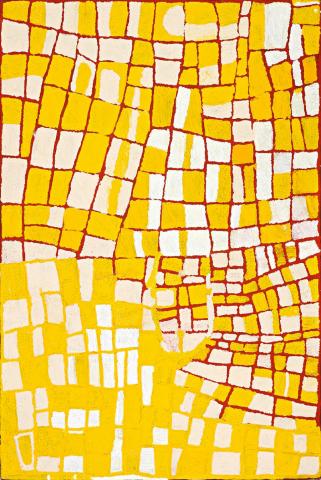WATI KUTJARRA AT THE WATER SITE OF MAMARA, 2000
TJUMPO TJAPANANGKA
synthetic polymer paint on linen
180.0 x 120.0 cm
inscribed verso; artist's name, size and Warlayirti Artists cat. 967/02
Warlayirti Artists, Balgo Hills
Gallery Gabrielle Pizzi, Melbourne
Private collection, Melbourne
Tjumpo Tjapanangka began painting in 1986. His early works adhered to the classic style of depicting the travels of the Tingari ancestors by painting interconnected circles, although with a Wirrimanu twist. He went on to develop a structure in his paintings that focuses on the spare arrangement of symbolic elements surrounded by a charged energy field of pulsating lines. His conservative use of colour highlights the key motifs and draws the eye through the composition in the manner of an animated narrative.1 Wati Kutjarra at the Water Site of Mamara, 2000, relates part of the story of the Wati Kutjarra, a prominent Dreaming in the Tanami and the Great Sandy Deserts. The Wati Kutjarra were two ancestral brothers who travelled large areas of the western desert teaching people about food, fire and hunting. This story takes place at the Water Site of Mamara, located far to the south of Balgo towards Wilkinkarra (Lake MacKay), The two brothers travelled to the country of Wilkinkarra before the lake was formed. It was here they lit a large fire, before moving beyond this country. The red lines indicate the intensity of the flames and the yellow and white, the tali (sandhills) which dominate this country.
1. Perkins, H., in Tradition today: Indigenous art in Australia, Art Gallery of New South Wales, Sydney, 2004, p. 194
